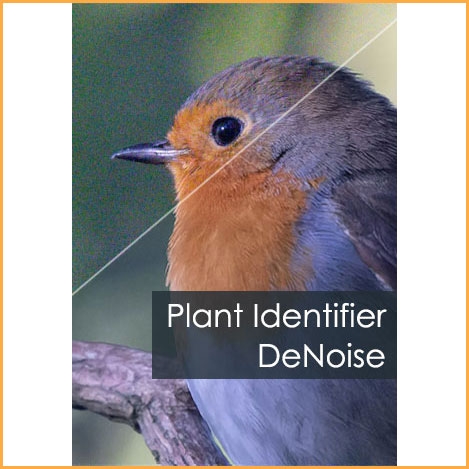Plant Identifier DeNoise
Buy Plant Identifier DeNoise now!
Plant Identifier DeNoise is able to correctly identify which pixels are unwanted noise, and which are actually part of the image, so as to ensure good noise reduction that results in a clean noise-free image that looks natural.
You will receive your code to redeem in your account within minutes by eMail. In order not to miss out the mail, please check the spam or junk mail folder too!
Please note: The download link will be sent to you via delivery eMail after you order.
Noise appears as random color or brightness variations across an image, which can give it a grainy or splotched appearance on close inspection.
There are two types of noise in digital photography, color noise and luminance noise. The former appears as colored speckles and the latter appears as a grainy effect. You can see both types of noise in the below image.

Both types of noise appear in some form in all digital images, however, there are a number of factors which can cause increased noise. The first of these is the ISO setting of your camera. As a general rule and all else being equal, the higher the ISO, the noisier the image will be.
This is because the ISO setting works a bit like the gain on an amplifier. As you increase the gain on an amplifier, the sound gets louder, but any errors or unwanted sounds also get amplified. As you increase the ISO on a camera sensor, the chance of random errors being recorded also increases. Images shot in lower light tend to be noisier due to the high ISOs used in these scenes.
The size of the sensor and the physical size of the pixels recording the light on the sensor also contribute to image noise. Smaller sensors with higher megapixel counts tend to create noisier images. Larger sensors with smaller megapixel counts tend to create less noisy images.
Whilst noise is normally undesirable in photography, there may be times where a photographer doesn’t mind noise in a photo or even wants it. For example, if trying to achieve a certain effect for a vintage or grungy style of photo, noise might be of value.
However, noise is generally something most photographers want to avoid. When it can’t be avoided in camera by using low ISOs, then you will want to use noise reduction software to remove it from your processed image files.
What is Noise Reduction in Photography?
Noise reduction is basically the removal of digital noise which can appear in an image.
Because noise is random, it normally appears all across an image in an arbitrary manner. This makes removing noise a bit of a challenge, as the noise reduction tool needs to be able to correctly identify which pixels are unwanted noise, and which are actually part of the image. The unwanted noise pixels should be replaced with pixels that seamlessly blend into the existing image.
Too much noise reduction can result in lost image detail, giving an image a soft, almost plastic look. Too little noise reduction means your images can look like a grainy speckled mess. Good noise reduction should result in a clean noise-free image that looks natural.


